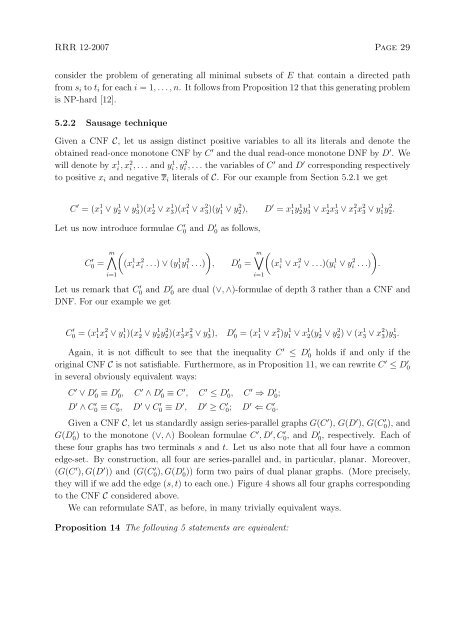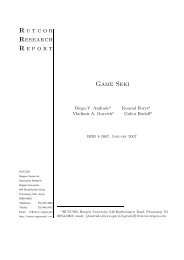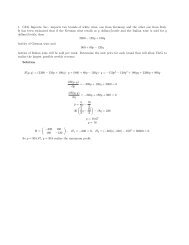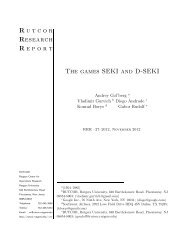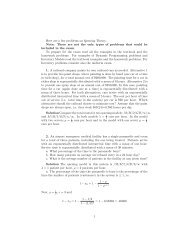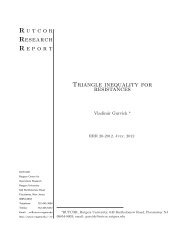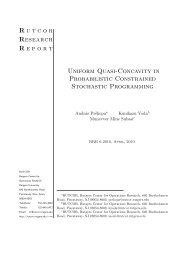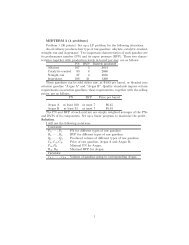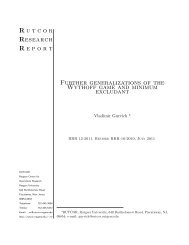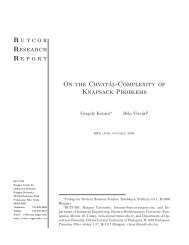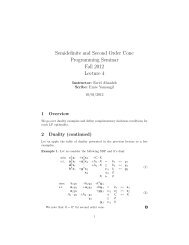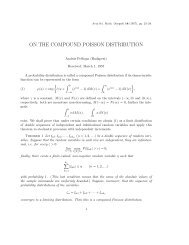Generating vertices of polyhedra and related monotone ... - Rutcor
Generating vertices of polyhedra and related monotone ... - Rutcor
Generating vertices of polyhedra and related monotone ... - Rutcor
You also want an ePaper? Increase the reach of your titles
YUMPU automatically turns print PDFs into web optimized ePapers that Google loves.
RRR 12-2007 Page 29consider the problem <strong>of</strong> generating all minimal subsets <strong>of</strong> E that contain a directed pathfrom s i to t i for each i = 1,...,n. It follows from Proposition 12 that this generating problemis NP-hard [12].5.2.2 Sausage techniqueGiven a CNF C, let us assign distinct positive variables to all its literals <strong>and</strong> denote theobtained read-once <strong>monotone</strong> CNF by C ′ <strong>and</strong> the dual read-once <strong>monotone</strong> DNF by D ′ . Wewill denote by x 1 i,x 2 i,... <strong>and</strong> y 1 i ,y 2 i ,... the variables <strong>of</strong> C ′ <strong>and</strong> D ′ corresponding respectivelyto positive x i <strong>and</strong> negative x i literals <strong>of</strong> C. For our example from Section 5.2.1 we getC ′ = (x 1 1 ∨ y 1 2 ∨ y 1 3)(x 1 2 ∨ x 1 3)(x 2 1 ∨ x 2 3)(y 1 1 ∨ y 2 2), D ′ = x 1 1y 1 2y 1 3 ∨ x 1 2x 1 3 ∨ x 2 1x 2 3 ∨ y 1 1y 2 2.Let us now introduce formulae C ′ 0 <strong>and</strong> D ′ 0 as follows,m∧()m∨()C 0 ′ = (x 1 ix 2 i ...) ∨ (y1y 1 1 2 ...) , D 0 ′ = (x 1 i ∨ x 2 i ∨ ...)(yi 1 ∨ yi 2 ...) .i=1Let us remark that C ′ 0 <strong>and</strong> D ′ 0 are dual (∨, ∧)-formulae <strong>of</strong> depth 3 rather than a CNF <strong>and</strong>DNF. For our example we geti=1C ′ 0 = (x 1 1x 2 1 ∨ y 1 1)(x 1 2 ∨ y 1 2y 2 2)(x 1 3x 2 3 ∨ y 1 3), D ′ 0 = (x 1 1 ∨ x 2 1)y 1 1 ∨ x 1 2(y 1 2 ∨ y 2 2) ∨ (x 1 3 ∨ x 2 3)y 1 3.Again, it is not difficult to see that the inequality C ′≤ D ′ 0 holds if <strong>and</strong> only if theoriginal CNF C is not satisfiable. Furthermore, as in Proposition 11, we can rewrite C ′ ≤ D ′ 0in several obviously equivalent ways:C ′ ∨ D ′ 0 ≡ D ′ 0, C ′ ∧ D ′ 0 ≡ C ′ , C ′ ≤ D ′ 0, C ′ ⇒ D ′ 0;D ′ ∧ C ′ 0 ≡ C ′ 0, D ′ ∨ C ′ 0 ≡ D ′ , D ′ ≥ C ′ 0; D ′ ⇐ C ′ 0.Given a CNF C, let us st<strong>and</strong>ardly assign series-parallel graphs G(C ′ ), G(D ′ ), G(C ′ 0), <strong>and</strong>G(D ′ 0) to the <strong>monotone</strong> (∨, ∧) Boolean formulae C ′ ,D ′ ,C ′ 0, <strong>and</strong> D ′ 0, respectively. Each <strong>of</strong>these four graphs has two terminals s <strong>and</strong> t. Let us also note that all four have a commonedge-set. By construction, all four are series-parallel <strong>and</strong>, in particular, planar. Moreover,(G(C ′ ),G(D ′ )) <strong>and</strong> (G(C ′ 0),G(D ′ 0)) form two pairs <strong>of</strong> dual planar graphs. (More precisely,they will if we add the edge (s,t) to each one.) Figure 4 shows all four graphs correspondingto the CNF C considered above.We can reformulate SAT, as before, in many trivially equivalent ways.Proposition 14 The following 5 statements are equivalent:


